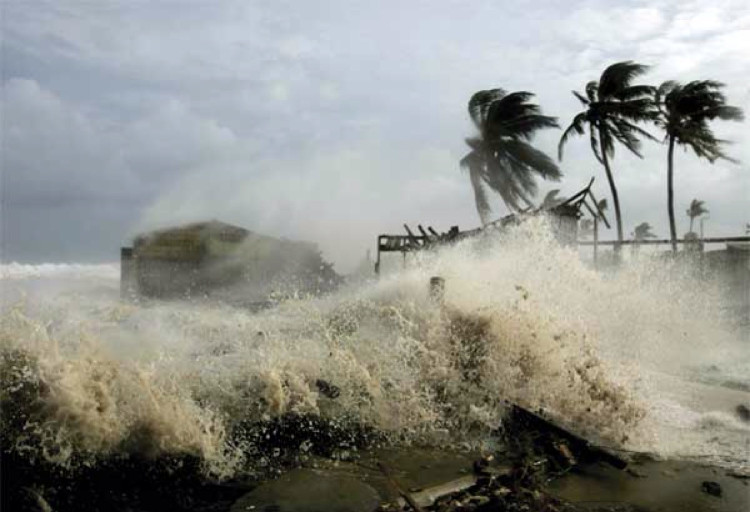Correct understanding of storms and tropical depressions
Storms and tropical depressions (NTDs) are quite familiar words to people when unusual natural phenomena occur. However, not everyone is aware of these two natural phenomena.
What is a tropical depression?
According to science, tropical storms and low pressures (tropical depression) are called tropical cyclones (cyclone) is a whirlwind region, with a diameter of hundreds of kilometers, formed in tropical waters. In the northern hemisphere, the wind blew into the center in an anticlockwise direction.
Atmospheric pressure in the storm is much lower than around and usually below 1000mb. The difference in air pressure in the center of the storm with surrounding areas is the cause of a very high wind speed.
Storm, tropical depression can be likened to a giant cake, when cutting the cake, we see that inside it, there is also the cake of the storm and the eye of the storm.
Thus, it can be seen that the storm is a whirlwind from the blowing sides into the storm center, the closer the center is, the stronger the wind, sometimes up to several hundred kilometers an hour, but in the middle is a relatively windy area light or windy is called a storm eye. The surrounding air was centered in the middle, not in straight lines but in a spiral.
In a storm, on the floor near the surface of the four-sided air, moving in the middle, to the middle of the storm, the air moves high and then radiates all over. Typhoons originate from tropical seas, moving a huge mass of moist air. This humid air mass moves upward, the water vapor that it contains condenses into clouds and causes rain, so the storms not only have strong winds but also thick cloud cover and heavy rain.

A strong storm is approaching the land.(Illustration).
Differences between tropical depressions and tropical storms
When tropical depressions are strong enough to continuously develop enough energy to attract strong winds and steam, a tropical storm will form. Tropical storms are nouns translated from 'tropical storm' English words . The difference between tropical depression and tropical storm is distinguished by wind level.
According to the wind division of the Irish Admiral Francis Beautfort, the wind is divided into 13 levels from 0 to 12. When strong winds from level 6-7 are called tropical depressions.
Today, sometimes wind storms are described as being in the Beaufort scale from 12 to 16, which is closely related to the corresponding speed level of the Saffir-Simpson hurricane scale, in which real storms are measured. , in which level 1 of the Saffir-Simpson hurricane scale is equivalent to level 12 on the Beaufort scale. However, the extension levels in the Beaufort wind scale above level 13 did not match the Saffir-Simpson hurricane scale.
- According to the international definition, tropical storms must have more than 64 km / h (or 35 knots) of wind , which is more than level 8. If the wind is weaker than 63 km / hour, it is called a tropical depression.
- If it is 118 km / h (12, 64 knots), the storm is called a big storm with typhoon.
- There is also a very strong storm or super typhoon (intense typhoon, super cyclonic storm, very intense tropical cyclone) with strong winds of more than 240 km / h (or more than 130 knots), ie level 4 in the Saffir hurricane ladder - Simpson or level 15 (Hurricane Beaufort) or more.
The noun 'typhoon' is used in the South China Sea and the Pacific Northwest; 'hurricane' in the Atlantic region; and 'tropical cyclone' in the Indian Ocean region.
- Tropical depressions may intensify into storms when approaching the Spratlys
- Tropical depressions are likely to become strong storms towards the North
- Latest news about tropical depression
- Occurrence of tropical depressions in the East Sea is likely to increase to a storm
- News of nearshore tropical depressions and tropical depressions near the East Sea
- Tropical depressions enter the South China Sea, potentially strong into storms
- Vietnam must receive 6-7 storms and tropical depressions
- Occurrence of tropical depression near the South China Sea, the possibility of strong storms
- Storms and tropical depressions will appear continuously this year
- Tropical depressions are likely to become strong storms, Bac Bo heavy rain
- Latest news about two tropical depressions consecutively in the South China Sea
- Tropical depressions are likely to become strong storms heading into the South China Sea
 Is the magnetic North Pole shift dangerous to humanity?
Is the magnetic North Pole shift dangerous to humanity? Washington legalizes the recycling of human bodies into fertilizer
Washington legalizes the recycling of human bodies into fertilizer Lightning stone - the mysterious guest
Lightning stone - the mysterious guest Stunned by the mysterious sunset, strange appearance
Stunned by the mysterious sunset, strange appearance After El Nino, it's La Nina again: 13 storms predicted in the East Sea, all at the end of the year?
After El Nino, it's La Nina again: 13 storms predicted in the East Sea, all at the end of the year?  Climate change can reduce the frequency of storms and tropical cyclones
Climate change can reduce the frequency of storms and tropical cyclones  Tropical forests are losing their ability to absorb carbon
Tropical forests are losing their ability to absorb carbon  Tropical depressions move quickly at sea, with the possibility of strong storms
Tropical depressions move quickly at sea, with the possibility of strong storms  Tropical depression Kajiki weakened in the East Sea
Tropical depression Kajiki weakened in the East Sea  3 depressions pressed on the sea, the Central faced unusual wind and rain
3 depressions pressed on the sea, the Central faced unusual wind and rain 